| Author |
 Topic Topic  |
|
Jacques M.
France
2668 Posts |
 Posted - Apr 30 2015 : 05:07:10 AM Posted - Apr 30 2015 : 05:07:10 AM


|
Hello,
I have received lately a very curious Contax II.
It had looked strange to me by the photos of the seller. No stopper for the selftimer and square shaped accessory shoe: two unusual details. The chrome was unusually shining. No visible serial number. As for the lens: a 2,8/5cm black Tessar of 1931. So, after some mails with Altix, I bought it.
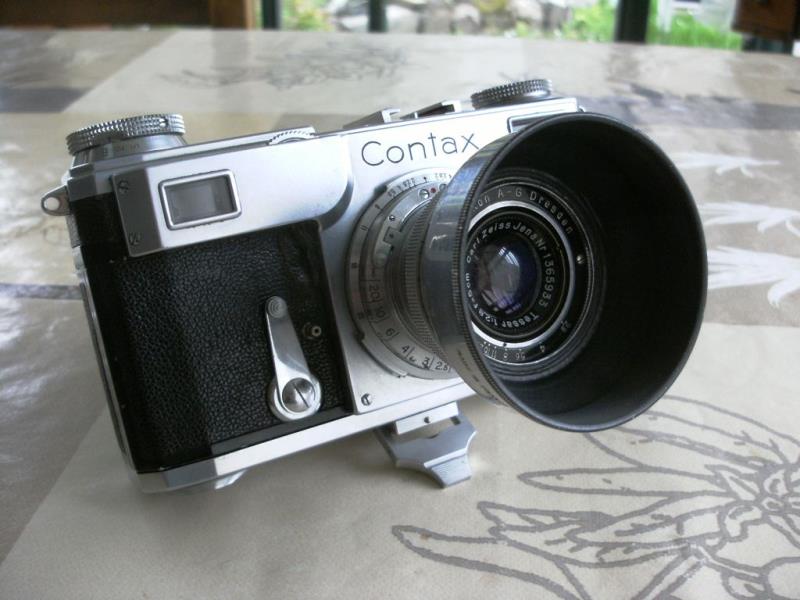
http://www.ussrphoto.com/UserContent/3042015_DSCF1890.JPG
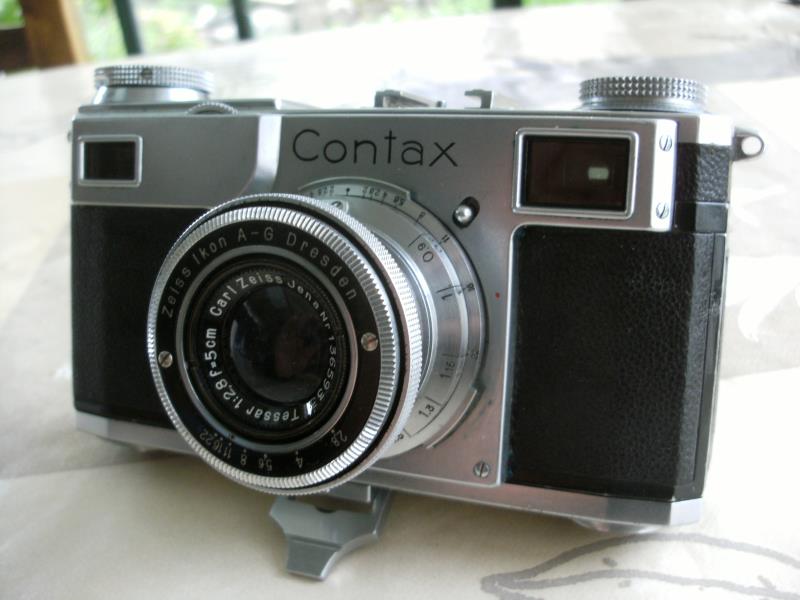
http://www.ussrphoto.com/UserContent/3042015_DSCF1893.JPG
I expected to receive a camera made with mixed Dresden and Jena parts.
But in fact, it is a completely original one, with different weights. For this camera: 505g for the body only (478g for the Contax II "O series"), 144g for the back (112g only for the "O") and 175g for my Jena Contax s/n 30xxx. But the back of the Jena Conatx is made of brass.
And if I try to inverse the backs, it's impossible...
|
Edited by - Jacques M. on Apr 30 2015 05:23:35 AM |
|
Jacques M.
France
2668 Posts |
|
Jacques M.
France
2668 Posts |
|
Jacques M.
France
2668 Posts |
|
Ulrich W.
uwittehh
Germany
877 Posts
My Collection
|
 Posted - Apr 30 2015 : 05:51:37 AM Posted - Apr 30 2015 : 05:51:37 AM



|
Jacques, very interesting Contax. What about the speeds? Does it have 1/250 or 1/200 ?
Ulrich
http://fotos.cconin.de |
Edited by - uwittehh on Apr 30 2015 05:59:47 AM |
 |
|
Jacques M.
France
2668 Posts |
 Posted - Apr 30 2015 : 06:03:40 AM Posted - Apr 30 2015 : 06:03:40 AM


|
Some other interesting détails.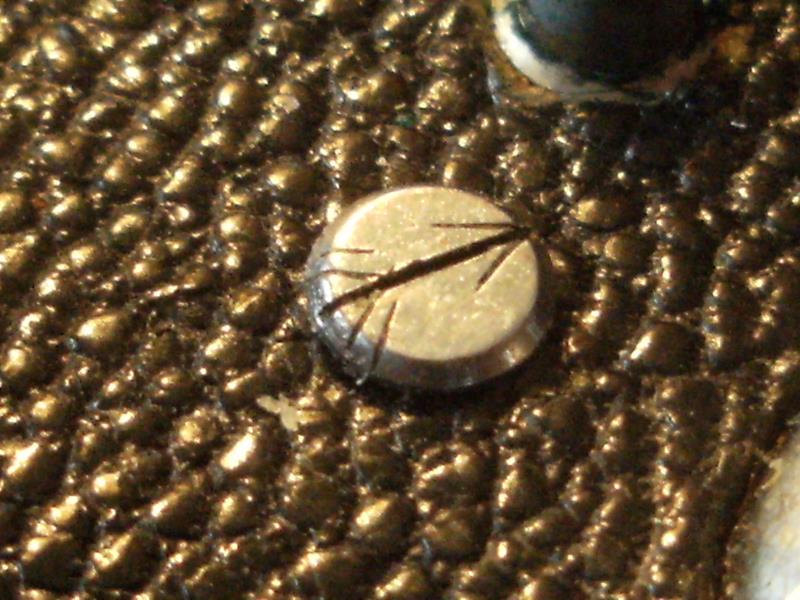
http://www.ussrphoto.com/UserContent/3042015_DSCF1873.JPG
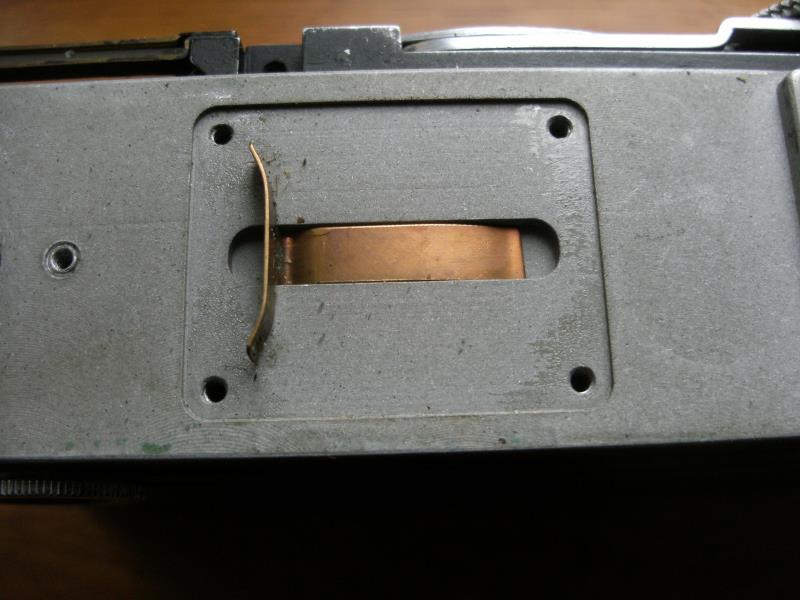
http://www.ussrphoto.com/UserContent/3042015_DSCF1913.JPG
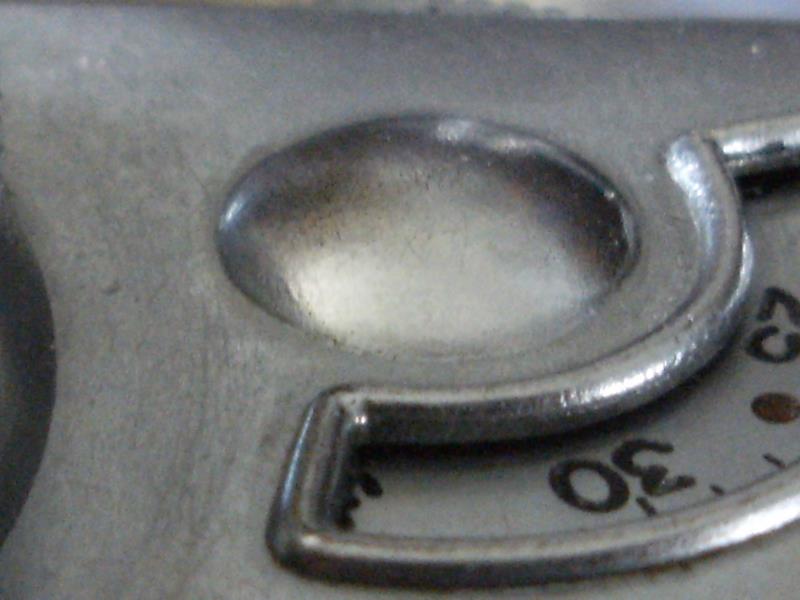
http://www.ussrphoto.com/UserContent/3042015_DSCF1958.JPG
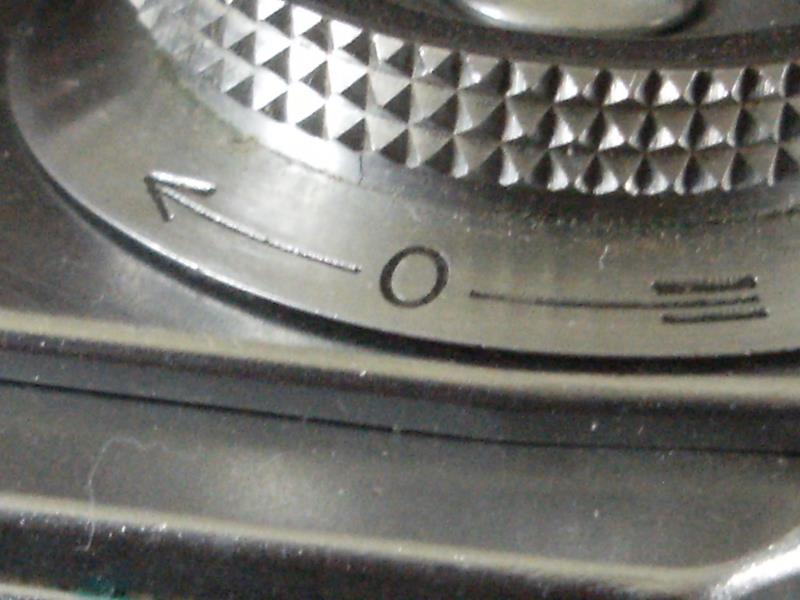
http://www.ussrphoto.com/UserContent/3042015_DSCF1951.JPG
It seems that all is the same, and all is a bit different between this Contax and the regular ones.
Unhappily, I could not dismount completely this camera. The main screws are too tight, which let me think that this camera was probably never dismounted.
In this camera, some parts come from Dresden, some others will be made in Jena for the Contax and Kiev Jenas. And some others are unknown and were never seen before...
We think that this camera is a prototype, certainly between the last Dresden Contaxes (O series) and the first Jena Contaxes, all that leading towards our Kievs.
The possible story: after the demand of the Red Army, Jena tries to build prototypes with the minimum of blue prints. This camera could be one of these. Some blue prints are found again after, so that the regular Jena Contaxes are more similar to the Contax II than this camera.
We wait for your comments...
Of course, I have plenty of other photos if needed!
Jacques. |
 |
|
altix
Ukraine
152 Posts |
 Posted - Apr 30 2015 : 06:25:46 AM Posted - Apr 30 2015 : 06:25:46 AM


|
I think it is important to mention that the position of engravings "B" "2" "5" on the shutter speed selector is different from the standard one so that the cocking the shutter for these speeds became easier. It seems that the shutter cocking mechanism was redesigned.
There is also no possibility to adjust the vertical alignment of rangefinder as on the standard models.
The self-timer construction seems to be different. At least it has lacks two stoppers of the self-timer lever and its housing is larger as the standard one.
The camera has no numbering of main camera blocks like on the mass-production models. There is no number on bayonet at all. This means that the bayonet was assembled for this camera only.
I also believe that this camera is some sort of prototype or a camera that was created to show Soviet authorities the possible design of post-war Jena Contaxes or Kievs.
|
Edited by - altix on Apr 30 2015 06:29:08 AM |
 |
|
Jacques M.
France
2668 Posts |
 Posted - Apr 30 2015 : 06:58:29 AM Posted - Apr 30 2015 : 06:58:29 AM


|
This camera has the regular range, Ulrich.
So, 1/125th and 1/250th.
The 1/100th and 1/200th were for the Z (and some A) pre series of Contax II.
But the present camera doesn't belong to that generation.
Thanks, Altix, for the complements.
Amitiés. Jacques. |
 |
|
Ulrich W.
uwittehh
Germany
877 Posts
My Collection
|
 Posted - Apr 30 2015 : 07:01:05 AM Posted - Apr 30 2015 : 07:01:05 AM



|
Excuse my question, but what makes you both sure that it is a postwar camera? Couldn't it be that this is a prototype of the normal prewar Contax II? ;-)
-- OK, question answered by Jacques ---
Ulrich
http://fotos.cconin.de |
Edited by - uwittehh on Apr 30 2015 07:02:10 AM |
 |
|
Jacques M.
France
2668 Posts |
 Posted - Apr 30 2015 : 07:38:48 AM Posted - Apr 30 2015 : 07:38:48 AM


|
There is something else, about the lens, that time.
It is a black Tessar made in 1931 which is coated (first and last glasses at least: I have not looked inside).
The coating was not deposit before 1936 or 37 by Zeiss (I don't remember exactly when) and so, it must have been made after on this lens. Not impossible, of course. But unusual.
It would have been much easier to put a contemporary coated lens. So, why?
Jacques.
Correction: the T coating was patented in 1935, but was kept secret for five years, by Kuc. |
Edited by - Jacques M. on Apr 30 2015 08:35:26 AM |
 |
|
Ulrich W.
uwittehh
Germany
877 Posts
My Collection
|
 Posted - Apr 30 2015 : 10:16:14 AM Posted - Apr 30 2015 : 10:16:14 AM



|
Jacques, I have read the "conkie" documents again and have found one interesting passage in them.
In german it says this:
"17.04.1946 Um die Erstellung der Kamera-Nullserie von 100 Stück schnell zum Anlauf zu bringen, wird angeordnet, dass bis zum 30.05. Teile auch von Hand oder auf halbfertigen Werkzeugen zu erstellen sind. Für de 100 Kameras muss Material für 300 Sätze angefertigt werden. In neun Untergruppen werden Gehäuse, Gehäusekappe, Rückwand, Objektivplatte, Vorlaufwerk, Hemmwerk, Vorhang, Vorhang komplett und Verschlusskappe in Jena vormontiert und zur weiteren Verarbeitung nach Saalfeld geschickt."
Google translates it to this:
"04/17/1946: To bring the production of camera-pilot series of 100 units to start soon, is arranged such that up to 30.05. Parts by hand or semi-finished tools to are creating. For de 100 cameras Material for 300 sets will be called for. in nine Subgroups are housing, housing cap, rear, lens drive forward work Hemmwerk, Preassembled curtain, curtain completely and cap in Jena and for further processing sent to Saalfeld."
Interesting is, that it says that camera parts have to be made by hand or with with semi-finished tools. That could be a reason why the screws on your camera are of othe size than on normal Contax II. So maybe the camera you have is one that was made of this hand made parts?
Ulrich
http://fotos.cconin.de |
Edited by - uwittehh on Apr 30 2015 10:17:40 AM |
 |
|
Jacques M.
France
2668 Posts |
 Posted - Apr 30 2015 : 3:52:04 PM Posted - Apr 30 2015 : 3:52:04 PM


|
Yes, Ulrich. It could be something like that.
A prototype made before the regular series.
And certainly, there were other ones, to assure the Soviets that Jena was always able to make cameras.
And when I see the quality of the chrome, really splendid, I wonder too if it was not a camera for exhibition rather than for use.
Anyway, certainly it was made before the drawings and blueprints were restored. If not, the differences with the Contax II O series and the Jena Contaxes would not be so important.
Just a detail: the rangefinder is of the Jena type, but the colours are yellow/green (Dresden, then Kiev patch) rather grey on grey (Jena Contaxes)
Thanks for the extract!
Amitiés. Jacques. |
Edited by - Jacques M. on Apr 30 2015 4:10:57 PM |
 |
|
SteveA
United Kingdom
134 Posts |
 Posted - May 01 2015 : 3:17:52 PM Posted - May 01 2015 : 3:17:52 PM


|
| Hi. My suspicion is that this camera was made up from blanks recovered from the Zeiss Dresden factory. Firstly, the engraving of the stops on the focus mount is different either a Dresden or Jena Contax, or the Kiev. Same applies to the rewind knob and self-timer release. The back looks to be hand-made from sheet material with extra re-inforcing to take the place of the pleats in the standard camera back - probably no new completed camera backs were available. The 'C' of Contax is also a different shape to any I have seen on Dresden or Jena. This may fit with the 1946 batch of hand-made cameras. For the Jena Contaxes and Kiev's, missing dies were reverse-engineered from available parts, new blueprints were drawn up (the camera was originally to be called the Volga before Kiev was arrived at). Very interesting camera you have there! |
 |
|
Luiz Paracampo
Luiz Paracampo
Brazil
2009 Posts
My Collection
|
 Posted - May 01 2015 : 3:20:11 PM Posted - May 01 2015 : 3:20:11 PM



|
Carefully seeing photos I can say the following:
The difference of weight is due the availiability of materials.
also to screws anf black paint on Shutter curtain.
Some manufacturing diferences is due mixing old Dresden parts with new manufacture.
The differnce in focusing range- is the absence of a limiting screw, which was result of a manufacturing without a previous plan.
The most importante is the chrome! It seems from the same procedures of TSVVS! Please compare!
This câmera could be a reprototypyng for a new manufacturing issue
Regards
LP |
 |
|
Luiz Paracampo
Luiz Paracampo
Brazil
2009 Posts
My Collection
|
 Posted - May 01 2015 : 3:29:10 PM Posted - May 01 2015 : 3:29:10 PM



|
A very strange point is the location of flash contact!
Placed in a difficult place with PC terminal !
In 1947 there were no contacs in such form They only appeared in 1952!
The contact is do well placed that it seems not to be made outside factory.
More the position needs to have na imperative modification in the self-timer structure
This can be confirmed by the engravings on outside release.
Regards
LP
My dear Jacques I shall contract you as a câmera Sherlock to find such rarities ! |
 |
|
Jacques M.
France
2668 Posts |
 Posted - May 02 2015 : 05:18:59 AM Posted - May 02 2015 : 05:18:59 AM


|
Thanks , Steve.
About the chrome, I share your opinion, Luiz.
It's the same quality on this prototype and the TSVVS, just perhaps a bit more shiny on the Contax.
Since the beginning, I have put the two cameras side by side. The general metallurgy is of course different (neat square angles for the Contax concerning the two plates and the cover; rounded angles for the TSVVS), but the "feeling in the hand" is quite the same. The sensation that these two cameras were the best for these years.
I take some more photos about the bayonet mount and the engravings.
Jacques. |
 |
|
Jacques M.
France
2668 Posts |
 Posted - May 02 2015 : 05:43:46 AM Posted - May 02 2015 : 05:43:46 AM


|
So, about the focus range.
It's not a question of limiting screw, but really a difference between the two helicoïds.
Please have a look at these two photos.
First, the Contax prototype
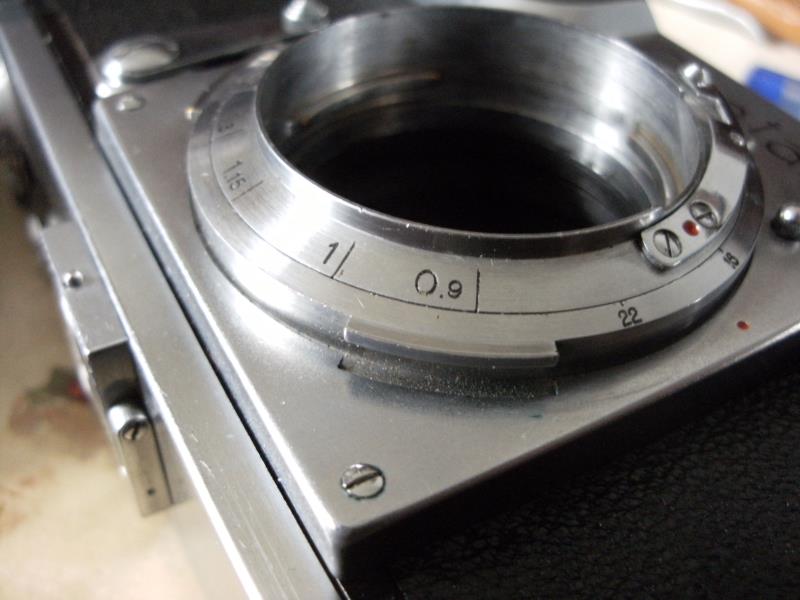
http://www.ussrphoto.com/UserContent/252015_DSCF2006.JPG
Then the Contax O series
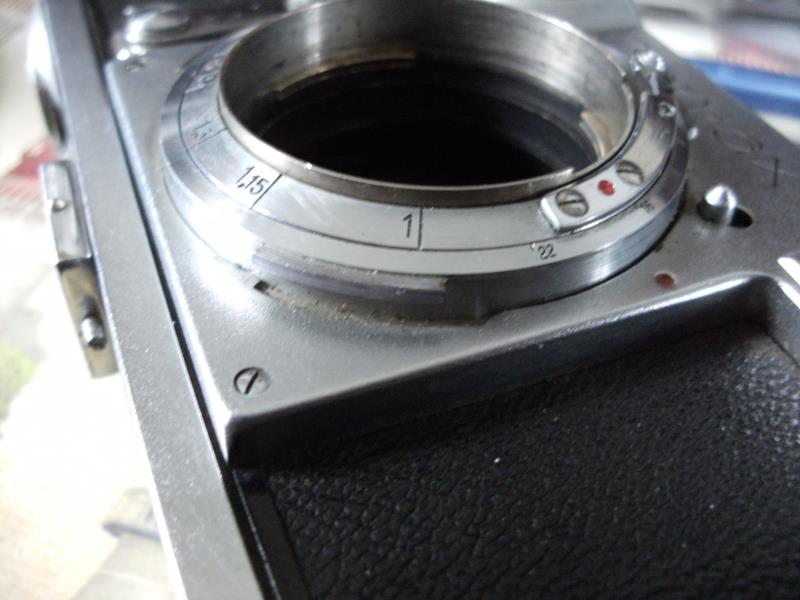
http://www.ussrphoto.com/UserContent/252015_DSCF2007.JPG
The helicoïd is at infinity for the two cameras. But on the prototype, the 0,9m has approximatively the same position as the 1m on the Contax II O series (and the Jena Contaxes, and the Kievs..)
On the whole range the positions of the same distances are different.
So, I think that the helicoïd is different too. And perhaps even the regulation of the rangefinder ??
|
 |
|
Jacques M.
France
2668 Posts |
|
Jacques M.
France
2668 Posts |
 Posted - May 02 2015 : 08:16:33 AM Posted - May 02 2015 : 08:16:33 AM


|
Two last photos about the mount.
Always some differences...
The prototype:
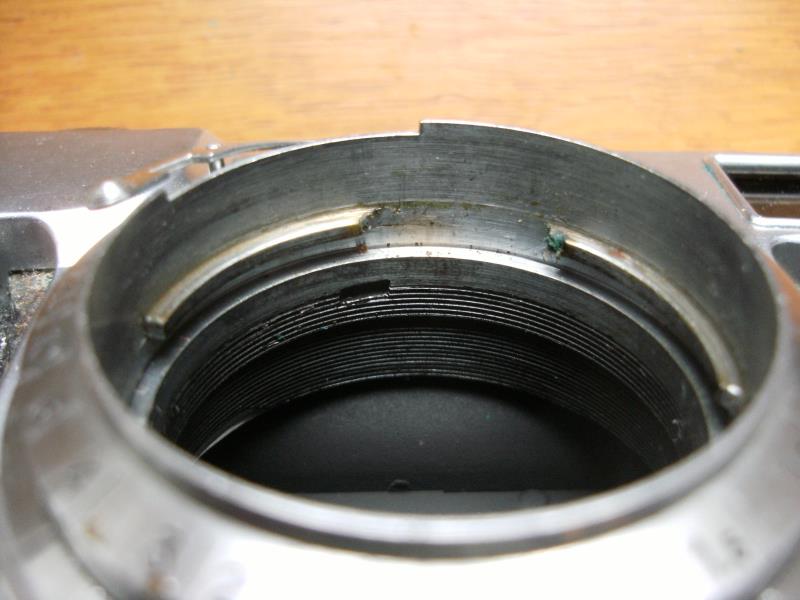
http://www.ussrphoto.com/UserContent/252015_DSCF2016.JPG
The Contax II O series:
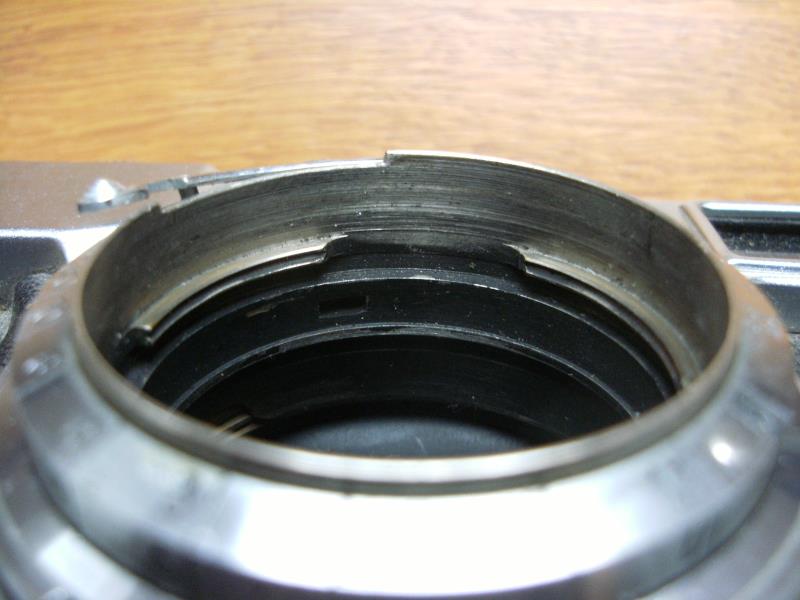
http://www.ussrphoto.com/UserContent/252015_DSCF2014.JPG
We really think, Altix and me, that this helicoïd/mount was specially made for this camera. The problem is that there is absolutely no inscription anywhere (at least on the parts I could dismount).
Thanks for the nickname "Sherlock", Luiz  I must say I have been rather lucky these last months. I must say I have been rather lucky these last months.
If somebody wants other photos...
Amitiés. Jacques.
|
Edited by - Jacques M. on May 02 2015 09:40:37 AM |
 |
|
altix
Ukraine
152 Posts |
 Posted - May 04 2015 : 3:33:17 PM Posted - May 04 2015 : 3:33:17 PM


|
A few remarks on this camera.
Here is an illustration that the shutter setting mechanism on this camera is different. The position of the engravings are not on the usual places (yellow color shows standard positions).
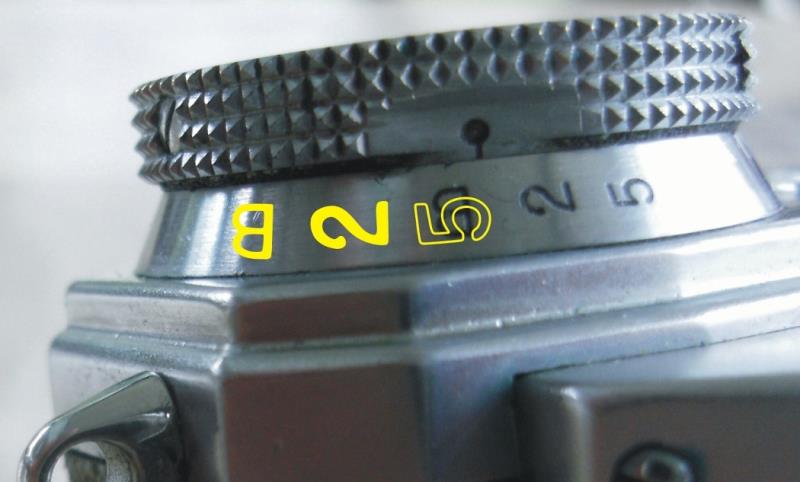
http://www.ussrphoto.com/UserContent/452015_G1.jpg
And here is the bottom of the camera with back door removed.
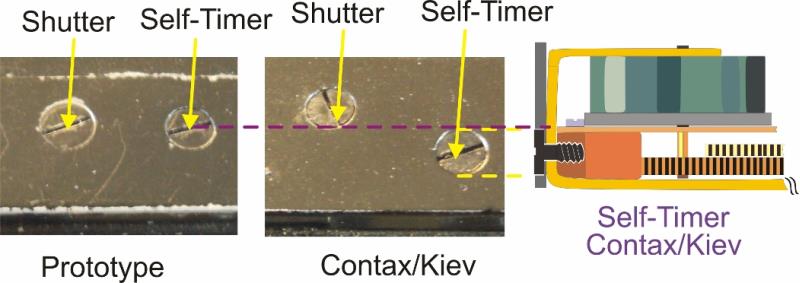
http://www.ussrphoto.com/UserContent/452015_G.jpg
Two bolts are shown that hold the shutter and the self-timer. One sees that the bolt that holds self-timer on its place is displaced from its standard position. On the right is a simple sketch of lower part of the self-timer mechanism. One sees the corresponding bolt (black). In the prototype the position of this bolt is displaced. The self-timer housing or even its mechanism should be different in order to allow the bolt hold the self-timer housing.
It seems that people who made this Contax had only part of all measurements of original Contax. It is hand made with many parts that were produced only for this camera.
Luiz idea about the synchronization is very interesting. I wonder too how one can synchronize the shutter with flash socket on the left side of the camera. The Rontgen shots of the camera could say more.
|
Edited by - altix on May 04 2015 3:35:00 PM |
 |
|
Jacques M.
France
2668 Posts |
 Posted - May 04 2015 : 4:17:53 PM Posted - May 04 2015 : 4:17:53 PM


|
Dear Altix,
Many thanks for your schemes...
No doubt. The inner modifications are of course much more important than what appears.
The problem is that all is screwed too tight: impossible to have a look inside. So, I certainly will ask Dr Mladek to Xray this camera, if possible. Unless somebody has a better idea?
Jacques.
|
 |
|
Luiz Paracampo
Luiz Paracampo
Brazil
2009 Posts
My Collection
|
|
Jacques M.
France
2668 Posts |
 Posted - May 05 2015 : 06:55:45 AM Posted - May 05 2015 : 06:55:45 AM


|
Hi Luiz!
You say that this helicoïd should receive Nikon lenses...
I know the differences between Contax/Nikon mount, but you can say that just by the outside?
Has it something to see with the lens, a 2,8 Tessar, rather than a 1,5 Sonnar which is much better?
Jacques. |
 |
|
Luiz Paracampo
Luiz Paracampo
Brazil
2009 Posts
My Collection
|
 Posted - May 05 2015 : 11:44:17 AM Posted - May 05 2015 : 11:44:17 AM



|
My dear Jacques
Nikon or Contax mounts operates through two diferente principles
Normal lenses focuses through axial displacement together rangefinder
nothing anormal and exactly as all other câmeras.
Accessory objectives operates through ANGULAR displacement of the bayoner which differ on this prototype from Contax/Kiev câmeras
Remember that each accessory lens has its own helicoid whose angular displacement must equals the original câmera helicoid for correct focusing.
One can use normal lenses from Kiev, Contaxes or Nikon albeit their diferent focus length because he error will follow in the tolerance standards
But the angular evolvement of the telephotos will largely differ in the mounts not prepared to match. Remember each lens has its own focusing thread.
Regards
LP
|
 |
|
Luiz Paracampo
Luiz Paracampo
Brazil
2009 Posts
My Collection
|
 Posted - May 05 2015 : 12:00:44 PM Posted - May 05 2015 : 12:00:44 PM



|
From the outside!
observe the angle formed between the segmenst that came from the center of optical axis to 0.9 and the other to infinity
in this prototye it is much near to Nikons than true Contaxes
LP |
 |
|
Jacques M.
France
2668 Posts |
 Posted - May 05 2015 : 12:03:09 PM Posted - May 05 2015 : 12:03:09 PM


|
I could think twice before posting...
When you explain, it's so evident!
Thanks, once more time!
Jacques. |
 |
|
altix
Ukraine
152 Posts |
 Posted - May 07 2015 : 06:37:58 AM Posted - May 07 2015 : 06:37:58 AM


|
Dear Jacques and Luiz
My explanation of this strange "Nikon" bayonet is very simple. Most probably Zeiss engineers were asked by Soviets to construct new Kiev cameras in such a way that it would accept optics with Leica-standard lens flange-to-film plane distance. Since Soviets were concentrated on mass production in huge quantities of interchangeable lenses this requirement would simplify the production of lenses for FED-like and Contax-like cameras.
It seems that Nikon chosen this strange bayonet pitch by mistake and it seems that Zeiss had requirement to go to Leica standard but by some reason this idea was abandoned. Probably Soviets had too much Contaxes from Dresden to refurbish them with new bayonets.
best regards
altix |
 |
|
Jacques M.
France
2668 Posts |
 Posted - May 07 2015 : 07:10:27 AM Posted - May 07 2015 : 07:10:27 AM


|
If you are right, altix, that question could be one of the purposes of this prototype.
That would explain too the hole in the back:
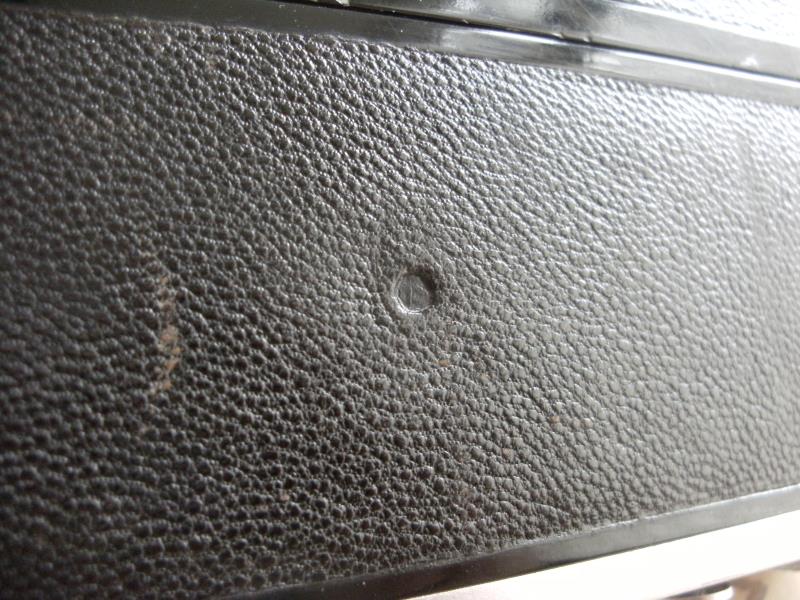
http://www.ussrphoto.com/UserContent/752015_DSCF1895.JPG
Amitiés. Jacques
Correction: No. The hole in the back is not in the axle of the lens...
|
Edited by - Jacques M. on May 08 2015 10:42:38 AM |
 |
|
SteveA
United Kingdom
134 Posts |
 Posted - May 08 2015 : 10:26:56 AM Posted - May 08 2015 : 10:26:56 AM


|
Hello Jacques.
Apologies if this repeat previous people’s observations on this special Contax. I have a book by Minoru Sasaki, which has many photos comparing Dresden, Jena Contaxes and Kiev’s. I have also compared various cameras in my own collection.
The different spacing of the shutter speeds is strange – basically for the Contax type shutter to achieve the ‘B’ setting it needs to be wound a specific distance. Now, if on this special Contax, the actual distance between 1:1250 and ‘B’ is less, than it implies the design and gearing of the shutter mechanism is totally different to either Dresden, Jena Contax or the Kiev.
Rangefinder screws (from the picture on ZICG pages, not posted here) – this is of the Dresden type.
Focussing mount – Engraved on the front face to 0.9 meters same as TSVVS and Nikon – the engravings are differently spaced to a standard Contax as 0,9 on my examples would line up with the first screw of the bayonet locking spring. So looks like a TSVVS type threaded portion of the mount was used – the outer part is different to either Jena , Dresden or Kiev as it is missing a slight kick-down in the pressing (bottom left as seen from the front of the camera).
Jena Contax focus mounts used a round topped number 3 with a comma for the decimal; the dot appears to start being used around 1949. So the flat topped Jena style 3 is interesting – the method of engraving looks different to the Dresden method, and to the TSVVS style.
Shield for large flywheel gear inside camera – this seems to be built into the camera body itself and is missing from the chrome front plate – again unique.
‘C’ of Contax is more like that seen on the post-war Contax IIa cameras, and is out of alignment with the rest of the name.
Bezel around the frame counter appears to be like the Jena Contax, i.e. more pronounced ridge.
This is certainly a strange camera - I wonder if it is worth contacting the Zeiss Historica Society for any information?
Cheers,
Steve
|
 |
|
Jacques M.
France
2668 Posts |
 Posted - May 08 2015 : 11:30:53 AM Posted - May 08 2015 : 11:30:53 AM


|
Hi Steve!
Many thanks for your comments! and if you have a Sasaki's book in double, think of me...
About the speed ring, there is no difference in the spacing, just in the position of the ring which was "turned" of some degrees to the right, when looking at the front of the camera. I must say that the speeds are fully working, except the "B" position.
The focussing range is special. Certainly, there must be an explanation: it's difficult to imagine that the engineers didn't know the basical characteristics of the Contax baionnet. So, the modifications would be dued to researches, as Altix says?
The inside of the mount is very interesting too, by its metallurgy. Even the internal baionnets are different...
I had forgotten to point the "Contax" logo. The "dancing" position of the "C" and the stroke of the "t" (too high!) were other strange détails, in fact the most evident at first glance.
I will contact soon the Zeiss Historica Society if we have no news through the ZICG.
Amitiés. Jacques. |
 |
|
Luiz Paracampo
Luiz Paracampo
Brazil
2009 Posts
My Collection
|
 Posted - May 08 2015 : 6:27:31 PM Posted - May 08 2015 : 6:27:31 PM



|
As you showed, this Contax has no Zeiss Ikon Logo at its back
Sure?
LP |
 |
|
Luiz Paracampo
Luiz Paracampo
Brazil
2009 Posts
My Collection
|
 Posted - May 08 2015 : 6:35:12 PM Posted - May 08 2015 : 6:35:12 PM



|
the synchro contact (if original- as it seems to be) means that this câmera was made after 1953 (in Germany) and 1955 (if in Russia)
LP |
 |
|
altix
Ukraine
152 Posts |
 Posted - May 09 2015 : 02:14:09 AM Posted - May 09 2015 : 02:14:09 AM


|
Dear Luiz,
The PC socket on this camera seems to be original. So it is also from 1953  
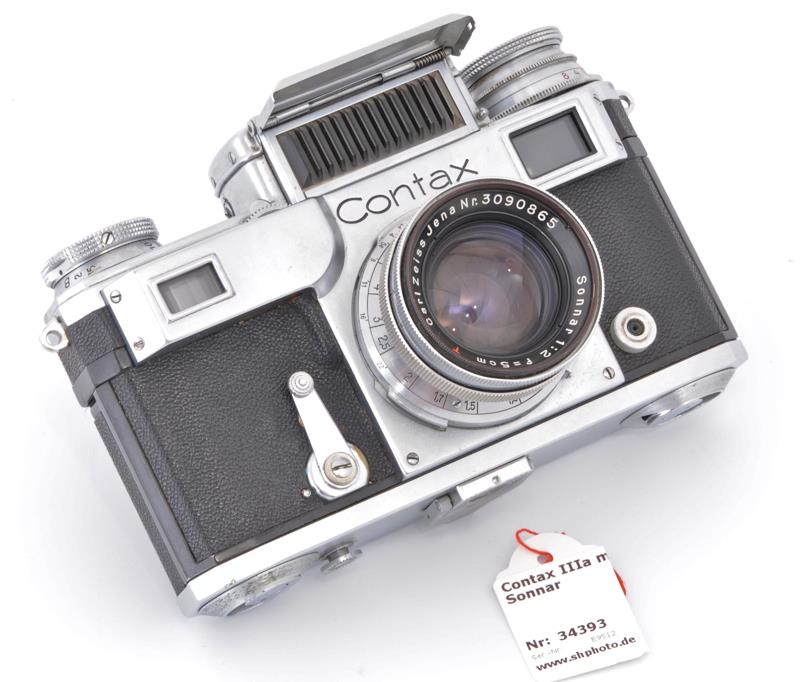
http://www.ussrphoto.com/UserContent/952015_51.jpg
Ok, jokes aside.
The PC socket of Jacques Contax looks like to be taken from the Prontor or Compur shutter. This connection is not professionally made. The flash synchronization cable can slip very easily which is irritating if you use disposable flash bulbs and your shutter does not allow double exposures (e.g. as on Nikon M,S). Initially flash synchronization slots were double like on Exaktas. The plug of synchronization cable in this case firmly connects to the sockets and cannot be easily slip during taking flash photography. This is because friction between socket and plug is twice as much for double connection than for the single one. The cable in this case is also not so easy to take out since you need to pull it strictly perpendicular to the plane with two sockets.
The Prontor and Compur shutters from fifties had one socket since it is the most elegant and cheapest way to attach the synchronization cable to central shutter. If you look on the PC connection on these shutters you will see that the shutter housing form a round rim around the PC connection itself. This rim helps to hold the plug and cause additional friction between the plug and the socket. This constructive feature protects PC plug to slip easily during taking the flash photography. In the same way all good PC connections on cameras have additional rim like the Jena Contax here http://www3.telus.net/public/rpnchbck/zconrfKiev.htm or PC connection on later Kiev cameras.
So I do not believe that this synchronization connector was done by Zeiss. The engineers there were not stupid to put the connector without the rim as they did on later Jena Contaxes. It was done by some repairman who had spare part from central shutter and used them for upgrading this camera. Same type of connectors without the rim I saw on several FED NKVD that were upgraded for flash photography. There sockets from central shutters were use in order not to spoil the top plate aesthetics.
with best regards
altix
|
 |
|
Jacques M.
France
2668 Posts |
 Posted - May 09 2015 : 03:16:40 AM Posted - May 09 2015 : 03:16:40 AM


|
quote:
Originally posted by Luiz Paracampo
As you showed, this Contax has no Zeiss Ikon Logo at its back
Sure?
LP
Absolutely sure, Luiz!
Jacques. |
 |
|
Luiz Paracampo
Luiz Paracampo
Brazil
2009 Posts
My Collection
|
 Posted - May 09 2015 : 7:00:02 PM Posted - May 09 2015 : 7:00:02 PM



|
seeing carefully pictures of those contaxes I feel none of them have original flash contacts
Regards
LP |
 |
|
Luiz Paracampo
Luiz Paracampo
Brazil
2009 Posts
My Collection
|
 Posted - May 09 2015 : 7:01:31 PM Posted - May 09 2015 : 7:01:31 PM



|
| as well as the last one of course isn't a IIIa |
 |
|
Jacques M.
France
2668 Posts |
 Posted - May 10 2015 : 05:34:24 AM Posted - May 10 2015 : 05:34:24 AM


|
Probably the first official factory made, on a late Jena Contax.
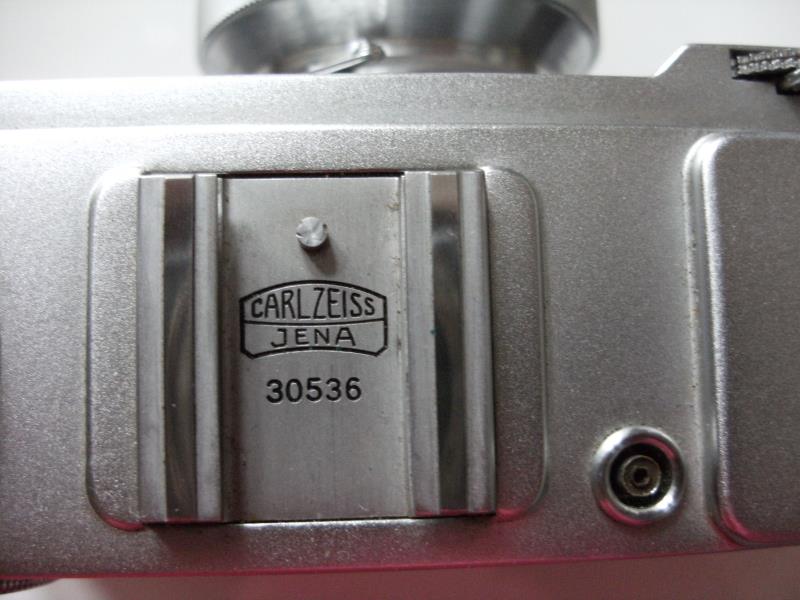
http://www.ussrphoto.com/UserContent/1052015_Photo 143.jpg
BTW, during the partial demontage, I found a tiny black cable of c.2cm length, in the rangefinder. No doubt it was for the flash. I took it out easily: it was free (not attached to anything). That makes think of a work made by a repairman.
Jacques.
|
 |
|
altix
Ukraine
152 Posts |
 Posted - Oct 18 2015 : 12:13:26 PM Posted - Oct 18 2015 : 12:13:26 PM


|
Hello,
Jacques was very kind to give me the opportunity to inspect the curious Contax. The inspection is not finished yet but I would like to share some observations and findings. I use for reference Jacques Kiev 1948 and my no-number Kiev that is almost Dresden Contax.
In general the curious Contax, which i tend to call "Ur-Contax Jena", is very well made camera assembled from well manufactured details and good materials. It is definitely the creation of camera production factory. Some details were modified after the production manually for better fit of details. In general it has very high similarity with the standard Contax cameras. However some mechanisms of the shutter were redesigned or improved.
The inspection of bolts that hold the shutter assembly showed that this camera was repaired someday. I tend to believe that it was the repairman who installed the flash synchronization mechanism. Some other details also support this conclusion. The synchronization mechanism is very smart and it seems that it was designed to work with bulb flashes only.
The most striking feature of Ur-Contax is the completely different concept of rangefinder focusing from the standard one. It is of Leica type (no sliding wedges anymore!) with original coupling to the bayonet.
Here is the picture of two partly dismantled bodies of Kiev 1948 (top) and Ur-Contax (bottom).
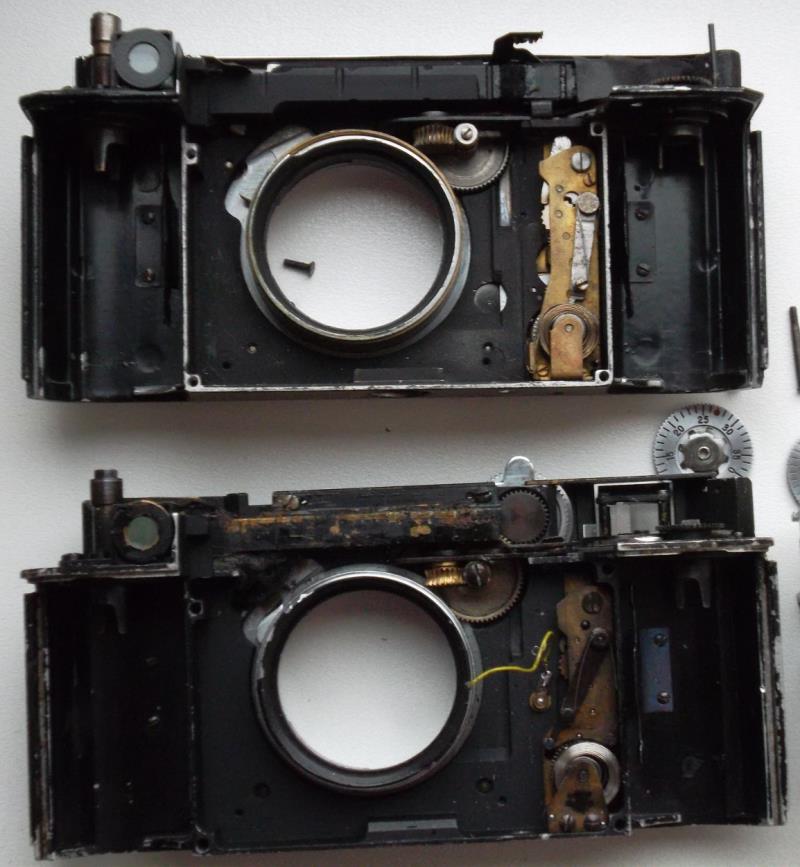
http://www.ussrphoto.com/UserContent/18102015_p5.jpg
The closer look into rangefinder mechanism. The brass tube (idicated by yellow) is hollow and was placed there in order to make the flare effects smaller. I am not sure if it was originally installed. Probably it is later modification together with synchronization

http://www.ussrphoto.com/UserContent/18102015_p6a.jpg
The drawing of rangefinder scheme from above for Ur-Contax (top) and Kiev 1948 (bottom)
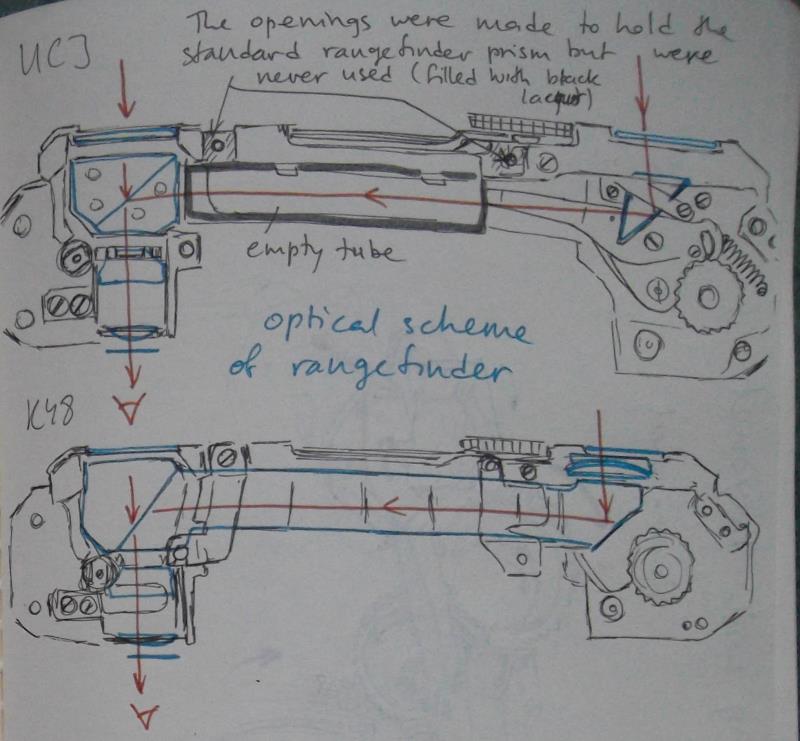
http://www.ussrphoto.com/UserContent/18102015_p1.JPG
The close-up of rotating mirror
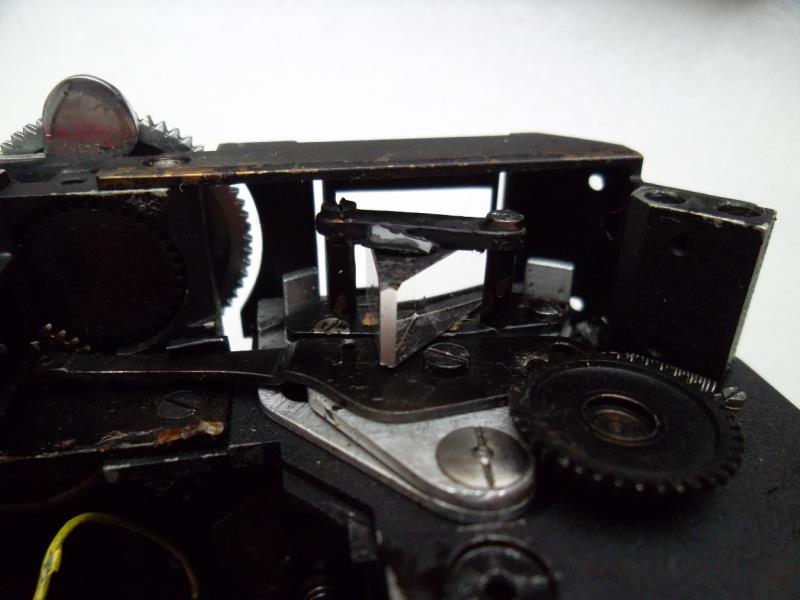
http://www.ussrphoto.com/UserContent/18102015_p3.jpg
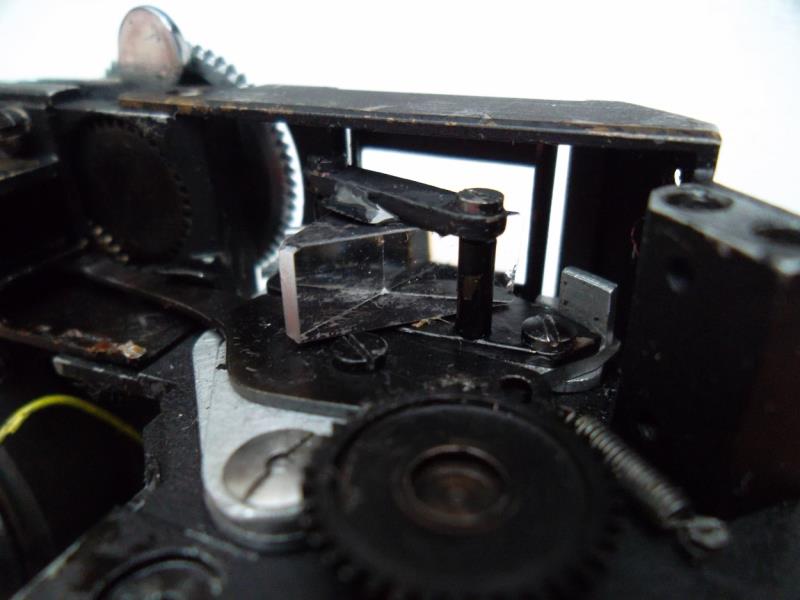
http://www.ussrphoto.com/UserContent/18102015_p4.jpg
The mechanical coupling to the bayonet is similar in many respects with the standard one. The mirror rotating mechanism and its coupling to the focusing wheel differs however in many respects from the mechanism of sliding wedges.
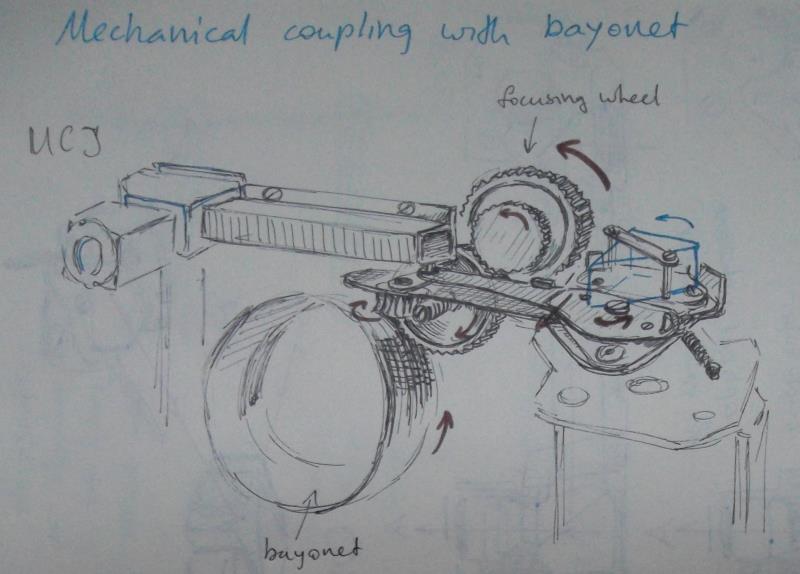
http://www.ussrphoto.com/UserContent/18102015_p2.JPG
This rangefinder was cheaper to manufacture than the standard one, however it gives poorer visibility and is less precise. I think that after trying this system on a prototype camera it was decided to equip after-war Contaxes and Kievs with the sliding wedge rangefinders.
altix
|
 |
|
Jacques M.
France
2668 Posts |
 Posted - Oct 19 2015 : 04:07:17 AM Posted - Oct 19 2015 : 04:07:17 AM


|
Fantastic job, Altix!
So, this camera is certainly a prototype based on the trial of a new rangefinder. I imagine the German workers, urged by the Red Army to build a new Contax range, trying different solutions to lower costs and spare time. All that before they could restore the drawings...
Certainly we will have other surprises with the mechanism and the bayonet.
Thanks, Altix, for your fine and perfectly clear drawings...
Amitiés. Jacques. |
 |
|
SteveA
United Kingdom
134 Posts |
 Posted - Oct 19 2015 : 05:27:37 AM Posted - Oct 19 2015 : 05:27:37 AM


|
Hi, the Contax type pencil prism and sliding wedges would have been quite a complex optical assembly to make. That optical wedge looks somewhat like the FED/Zorki type wedge, which coincidentally lived in a square tube in the FED. I think you are right - this looks like a 'what-if' prototype to see if the Leica/FED type RF could be used should the pencil prism etc., prove hard to manufacture. The gearing would have had to be re-calculated to allow for the approx 3 degree wedge movement needed to focus from 3ft to infinity.
Point is, when was it made? Was it an early prototype, or something that was later adapted to test the swinging prism set-up.
Cheers,
Steve |
 |
|
Jacques M.
France
2668 Posts |
 Posted - Oct 19 2015 : 07:13:54 AM Posted - Oct 19 2015 : 07:13:54 AM


|
Probably, this camera was made during a "hollow" period of the factory. By hollow, I mean a period of research, when you have nothing sure as a real basis to produce a complete camera.
An ordinary prototype would have been an adaptation . A Contax O series or a Jena Contax modified to try this new rangefinder. It's not the case here: we have too many new parts which are not in relation with the rangefinder. The "Contax" on the front, the chrome, the arrow on the rewind button, the main screws inside, the back, and even the camera body itself are slightly different.
But I don't have the camera for the moment. Altix will tell more, for sure.
Amitiés. Jacques. |
 |
|
altix
Ukraine
152 Posts |
 Posted - Oct 19 2015 : 1:42:44 PM Posted - Oct 19 2015 : 1:42:44 PM


|
Dear SteveA,
I think that the most logical answer on your question is that it is the early pre-series Contax Jena. It is hard to believe that after 1947 it was possible to manufacture the camera on such a high level. It is definitely original design and not something like black-market Contax assembled from spare parts.
In the article "Die Ur-Kiev kam aus Jena" (Photo Deal, IV 2005, p.56-59) Bernd K. Otto writes the following (sorry for my bad translation)
"The Russians insisted to show them prototypes. They wanted to see the results of camera development not written in the reports but to hold the prototypes in their hands. To this end the engineers needed to improvise. Already in April 1946 was asked Jena factory to assemble the zero-series of 100 cameras for tests by hand using the partly ready tools or with manualcraftmanship. "
"12 December 1946 started the program for testing the prototypes"
"Following the sequence and methodology of testing of new Kiev (Contax) cameras it was checked the work of the shutter on all speeds including the work of self-timer with and without film. It was also required to check the work of frame counter, the film transport during winding the shutter and rewinding of film (10-15 times). The rangefinder was checked if it shows the distance correctly and if the bayonet shows the distance correctly. Then cameras were tested on durability by transporting them in the carriage without springs in order to shake them, by testing the shutter in low temperatures (up to -40 grad C). The proof of the shutter under the low temperatures has shown that cameras could be used later in winter time on the territory of Soviet Union... "
So it seems that this particular camera has failed some tests, since I am not sure that the Leica rangefinder with such a huge rangefinder base could preserve its precision after the violent shaking. All in all sliding wedge mechanism is able to minimize the error due to slight misalignment much better than the mirror-based one. It can be that Russians have insisted to abandon this FED-Leica solution.
I need to measure somehow the thread pitch of screws of Ur-Contax. This can probably help to date the camera. I need to find the microscope or something like that.
with best regards
altix |
 |
|
Ulrich W.
uwittehh
Germany
877 Posts
My Collection
|
 Posted - Oct 19 2015 : 3:28:18 PM Posted - Oct 19 2015 : 3:28:18 PM



|
altix,
that is close to that what I have posted some times ago, that it could be one of those 100 prototype cameras that were partly made from handcrafted parts.
How much of them may exist today? Congrats to Jacques for that find.
Ulrich
http://fotos.cconin.de |
 |
|
SteveA
United Kingdom
134 Posts |
 Posted - Oct 20 2015 : 02:20:58 AM Posted - Oct 20 2015 : 02:20:58 AM


|
Hi Altix.
Regarding the different position of the 5, 2 and 'B' speed markings on the shutter bezel, did you find the reason for that during your dismantling?
Many thanks,
Steve |
 |
|
altix
Ukraine
152 Posts |
 Posted - Oct 20 2015 : 07:36:36 AM Posted - Oct 20 2015 : 07:36:36 AM


|
Dear Ulrich,
sorry not to refer to your comment above. The previous thread discussions were quite a long time ago I needed to reread and recollect some information.
I am puzzled with this camera since I cannot understand some modifications in shutter design. If Zeiss engineers were under the huge stress of Soviets then why the camera shows new design solutions? Did Zeiss engineers really have enough time to assemble this Contax? On the other hand I noticed the tendency in increase of details size (bolts, gears, levers) that one can connect with Russian requirements on high durability. At the same time I cannot see that the shutter of this Contax has significant simplifications in its construction. It has slight differences but the main operational principles and mechanics is inherited after Dresden Contax. So why engineers did not assembled simply the Dresden Contax replica? If somebody ordered to modify some mechanisms I need to understand why these attempts to change basic design were quickly abandoned.
On weekends I will try to analyse the shutter peculiarities in detail and post the results here.
with regards,
altix
|
 |
|
Jacques M.
France
2668 Posts |
 Posted - Oct 20 2015 : 08:20:02 AM Posted - Oct 20 2015 : 08:20:02 AM


|
Thanks for your congrats, Ulrich! But it's Altix who does the job now!
Of course you are right, Altix. I don't understand myself why there are so numerous modifications. Normally, only one parameter is studied in a prototype. Except at the beginning of a new series, which is not the case. As if there was nothing behind the engineers who conceived that camera...
So, perhaps we are we wrong? Is this camera a prototype of Contax II, in spite of the normalized speeds? (If yes, you would be right for the second time, Ulrich!)That would match with the lens, a Tessar 2,8/5cm s/n 1365933 which belongs to a batch of 1000 lenses delivered the 4/03/32, by the Thiele. But this lens is coated...
So....
Amitiés. Jacques. |
 |
|
altix
Ukraine
152 Posts |
 Posted - Oct 20 2015 : 08:39:16 AM Posted - Oct 20 2015 : 08:39:16 AM


|
quote:
So, perhaps we are we wrong? Is this camera a prototype of Contax II, in spite of the normalized speeds?
Dear Jacques, this is a reason why I need to measure the camera screw pitch  Here is one trick that I will explain if I manage to measure it. Here is one trick that I will explain if I manage to measure it.
I believe that it is the post war Contax. One cannot exclude also the possibility that it was assembled in Oberkochen. But why then there are so many Contax-Jena features? |
 |
|
SteveA
United Kingdom
134 Posts |
 Posted - Oct 21 2015 : 11:13:08 AM Posted - Oct 21 2015 : 11:13:08 AM


|
And a further observation, take a look at www.cameraquest.com/zconrfKiev.htm" target="_blank">http://cschu.redirectme.net/mirrored/cameraquest/www.cameraquest.com/zconrfKiev.htm
Observe the spacing of the letters for CONTAX on the 1947 Jena Contax, pictured slightly down the page. On our mystery camera they match the spacing for the Jena Contax, other than that the 'C' appears to be a slightly different shape. I checked all my Zeiss Ikon Contaxes and the lettering is much more closely spaced on them all.
Steve |
 |
|
SteveA
United Kingdom
134 Posts |
|
Jacques M.
France
2668 Posts |
 Posted - Oct 21 2015 : 3:48:53 PM Posted - Oct 21 2015 : 3:48:53 PM


|
Hi Steve!
I cannot open your links. Don't know why?
Generally speaking, there are slight variations in the spacing and the shapes, even inside the Jena-Contax series which is however quite "close". For example, the opening of the "C", the flatness of the "o" are well visible.
On this camera, the stroke of the "t" is higher than on any other Contax, Dresden or Jena. But you are right: the general look is more Jena than Dresden.
Jacques. |
Edited by - Jacques M. on Oct 21 2015 3:58:13 PM |
 |
|
SteveA
United Kingdom
134 Posts |
 Posted - Oct 22 2015 : 1:48:19 PM Posted - Oct 22 2015 : 1:48:19 PM


|
Hi Jacques, something odd happens when I paste the URL in. If you copy and paste the bit from 'cschu' through to 'zconrfkiev.htm' it links to Peter Hennig's pages. I'll have another go at pasting in in here: "cschu.redirectme.net/mirrored/cameraquest/www.cameraquest.com/zconrfKiev.htm"
Looking at my Contaxes again, the B serial number ones have the stroke of the t level with the top of the n, whilst the F serial number has it slightly lower. I believe from memory that there was more than one toolset producing components for Contaxes so the dies for body components had slight variations.
Steve
|
 |
|
xya
France
166 Posts |
 Posted - Oct 22 2015 : 3:20:13 PM Posted - Oct 22 2015 : 3:20:13 PM


|
| concerning the link I tried everything yesterday in a new post to keep it together, but in vain. I gave up and deleted the post. jacques, just copy everything within " " from cshu.. to kiev.htm (crtl+c) and paste it into the address bar of a new browser window. you are right, steve, the page is really interesting. |
 |
|
Ulrich W.
uwittehh
Germany
877 Posts
My Collection
|
|
Jacques M.
France
2668 Posts |
 Posted - Oct 23 2015 : 05:53:45 AM Posted - Oct 23 2015 : 05:53:45 AM


|
Yes, the article of Peter Hennig. Interesting and with beautiful photos. Note that Hahn's camera is in fact a Dresden Contax, mounted in Kiev, without selftimer. Problems with that part or was it unavailable?
About the stroke on the "t" of Contax, there are at least three positions:
- at the level of the other letters, on the first series of Contax, and too on the Jena-Contaxes,
- really under the level, up to the last wartime series (O series),
- really higher than this level on my prototype.
And there are other modifications too, in the spacing, the shape of the letters, the paint (or not on my "Z" preseries), etc. A monography would be necessary! And I think too that, on the prototype, the name "Contax" is rather on the Jena side.
Amitiés. Jacques.
|
 |
|
altix
Ukraine
152 Posts |
 Posted - Oct 26 2015 : 4:13:51 PM Posted - Oct 26 2015 : 4:13:51 PM


|
Dear all,
I will post some my remarks on shutter of the Contax. Actually, the closer look showed that the shutter is almost identical to the standard one. There are some minor variations in shape of some details but the operational principle is the same.
I observed that Contax has small deviation in shutter curtain construction. The following diagram shows these differences
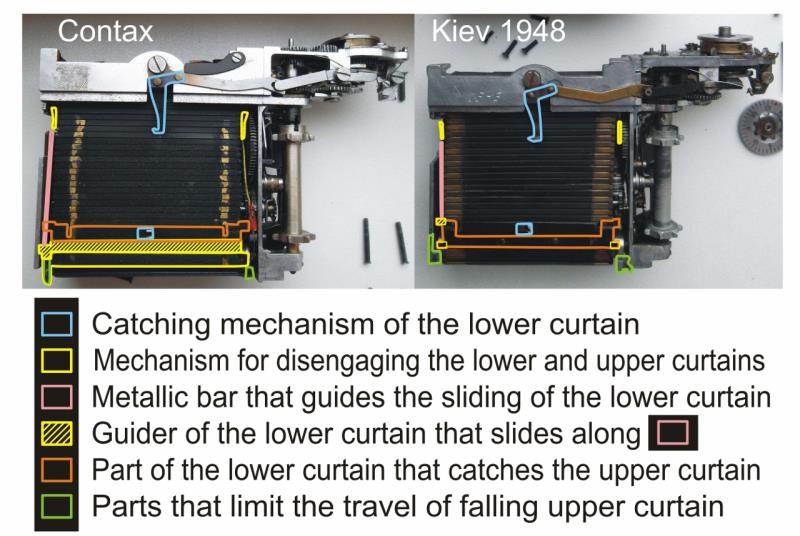
http://www.ussrphoto.com/UserContent/26102015_gr1.jpg
So one sees that in the standard construction (Kiev 1948) one part of the lower curtains (orange) has multiple functions, whereas in Contax all these functions are distributed among several slabs of the lower curtain.
The different position of shutter speed selector engravings have nothing to do with the shutter mechanism. It is rather connected with the difference in catcher position on winding knob relative to the black dot mark.
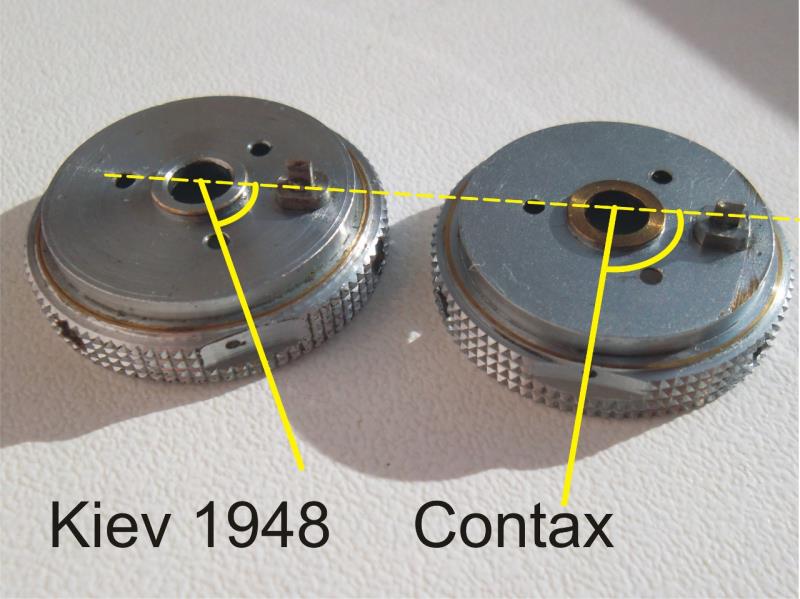
http://www.ussrphoto.com/UserContent/26102015_WKnob.jpg
Here are some shots of shutter winding mechanism.
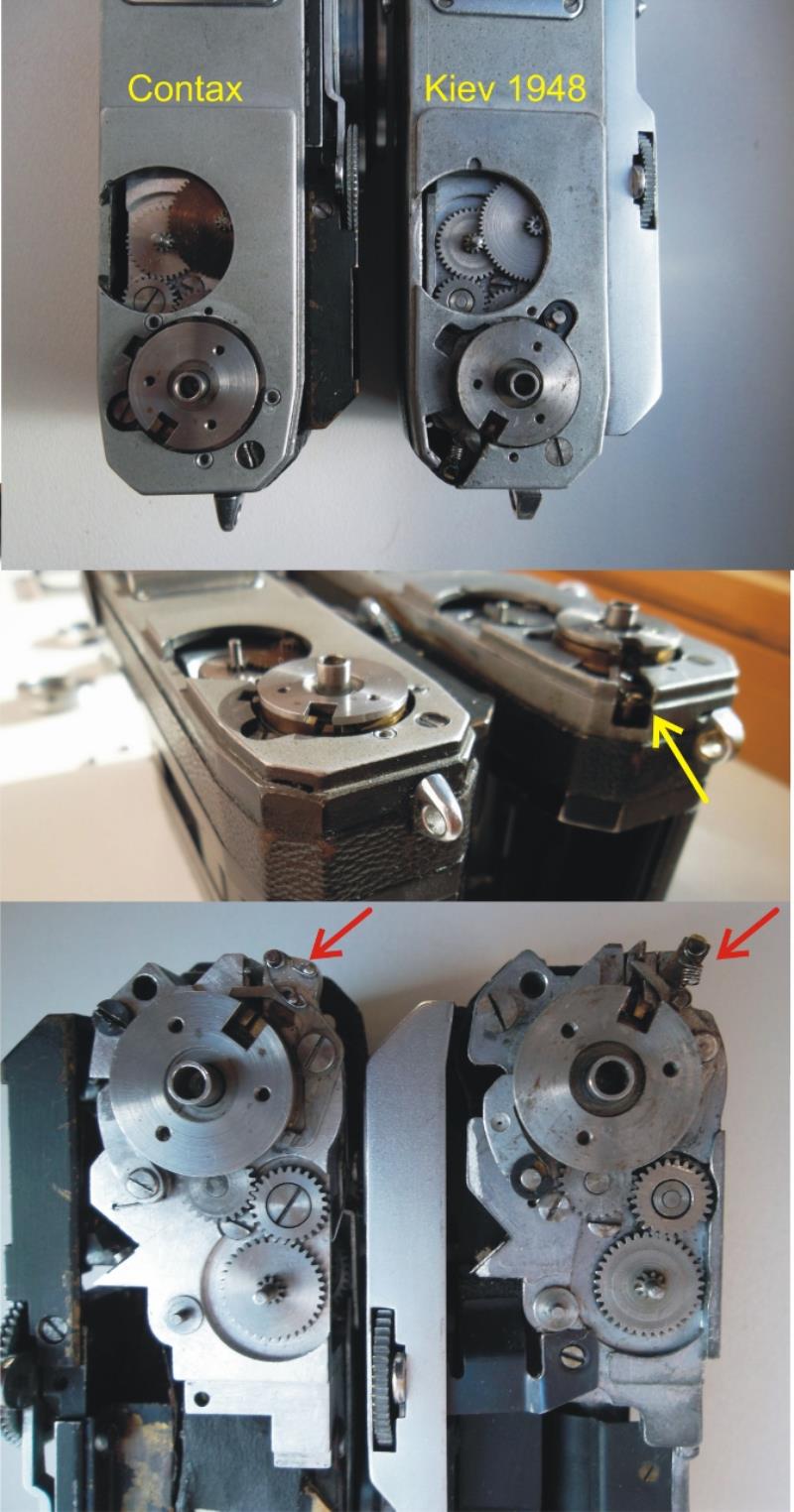
http://www.ussrphoto.com/UserContent/26102015_Shutters.jpg
I also have found that the rangefinder prism was connected with the hollow tube on the factory. I just wonder why this tube is too short.
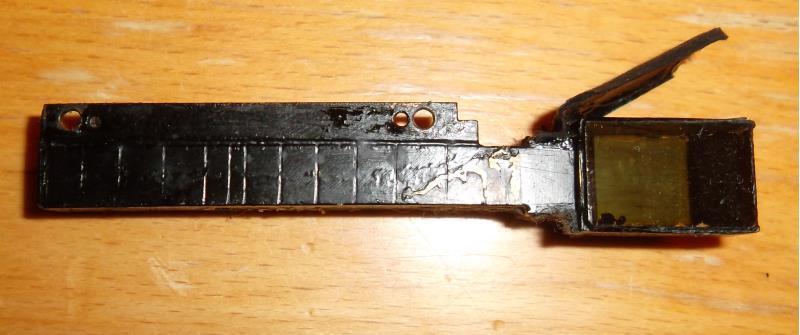
http://www.ussrphoto.com/UserContent/26102015_SAM_0971.JPG
The comparison of some details of Kiev no-number, Contax and Kiev 1948
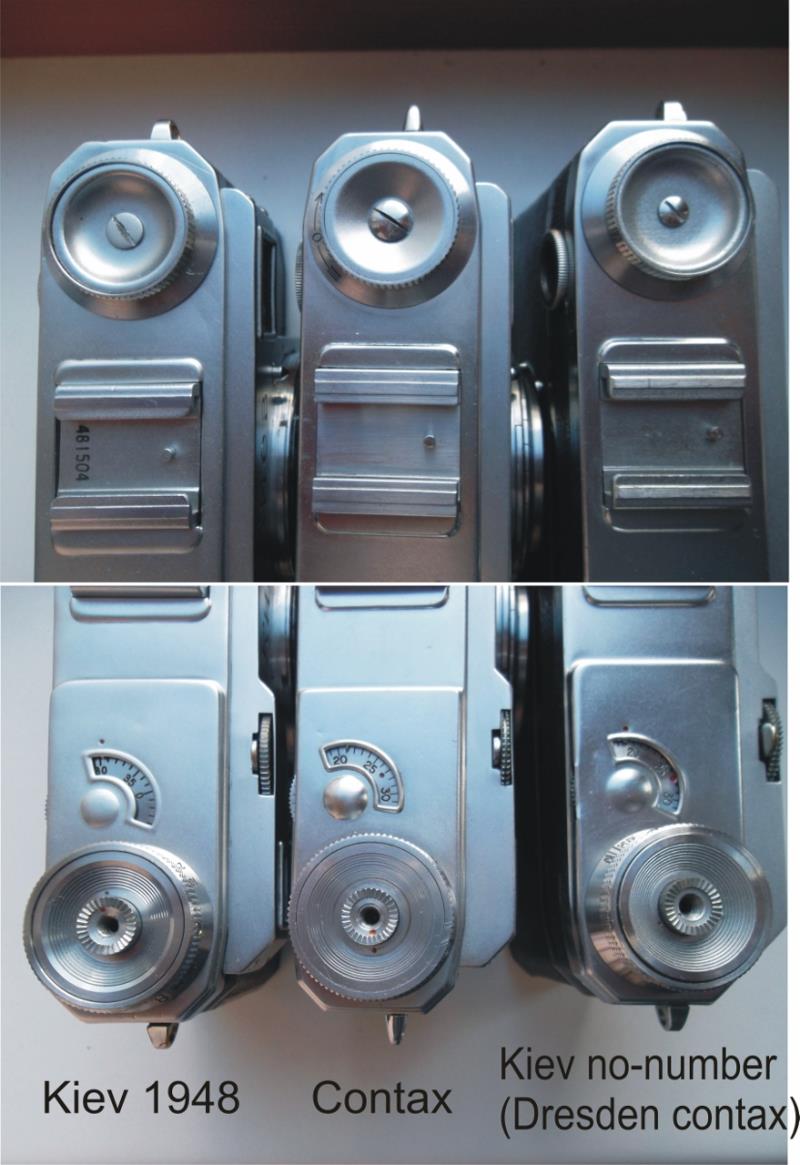
http://www.ussrphoto.com/UserContent/26102015_details.jpg
I would say that this Contax has 90% differences in comparison to standard model and is most probably the early prototype camera of Contax Jena. The main feature of this Contax is the Leica-type rangefinder with corresponding slight modifications of focusing system and bayonet. Other modifications are rather cosmetic ones.
altix
|
 |
|
SteveA
United Kingdom
134 Posts |
 Posted - Oct 28 2015 : 2:55:46 PM Posted - Oct 28 2015 : 2:55:46 PM


|
Hi Altix, I have 1948 Kiev number 481100, chassis engraved 1100. I did some work a number of years ago with Zeiss Historica, and Minoru Sasaki (who published 'Contax to Kiev - a report on the mutation). This involved stripping my 481100 Kiev and a 1941 Contax to compare details.
My Kiev has:
Dresden type blinds with leather heal,
Dresden focus mount and focus wheel,
Dresden type top chrome cover,
Jena type front chrome cover,
Dresden shutter chassis,
Dresden cut gears with the distinct bevelling which Jena tooling could not match,
Jena style film rewind knob.
The pencil prism looks to be Dresden, but has been badly ground/shaped to fit what is a Jena type front shell. This was done at the factory, not by someone later.
The shutter mechanism itself is very smooth, though the camera looks very worn (chrome rubbed off) - maybe this is a reflection of the poor availability of quality chrome after the war.
Cheers,
Steve |
 |
|
altix
Ukraine
152 Posts |
 Posted - Oct 29 2015 : 1:02:26 PM Posted - Oct 29 2015 : 1:02:26 PM


|
Dear Steve
thank you for information. I think that Kiev from 1948 are extremely interesting cameras. For me is hard to understand where and when was assembled any Kiev camera from this period. Say in 1948 the Kiev production in Jena was stopped but I also do not believe that all Kiev 1948 were assembled in Kiev. Say Kiev 481504 I showed here (this camera belong to Jacques) is very homogeneous camera. I have found only one Contax Dresden detail (one detail of rewind knob). So I can say it has Jena-like details.
The most complex detail of the camera is the shutter. I can imagine Kievs assembled in Arsenal in 1948 from semi-manufactured parts and such cameras should have Dresden Contax shutter. In the view of information I have I doubt that Arsenal workers were able to assemble Contax-like shutters in 1948. Probably only few such shutters were ever assembled in Arsenal that year. So why there exist cameras with Jena-type shutters and with very homogeneous Jena Kiev look? My answer (that can be wrong) is that these cameras were probably assembled in 1947. This assumption supports indirectly the information from Bernd Otto article (table here http://fotos.cconin.de/ussrphoto/conkie_7.pdf) and recollections of mister Widder (see J. Kuc book).
I noted that Kiev 1947-49 have different engravings of serial numbers: "Jena-like" and "Soviet-like" (look at the font of numbers "4"). I would be very happy if you could say which type of number do you observe on your Kiev. Jacques' camera has typical Jena font.
Concerning your observation of bad shaped prism it can mean that the prism was adopted in Arsenal from Dresden part. Jena workers produced optical elements for Contax very long time and were able to modify prism properly.
Funny enough I observed that the beam splitter in the curious Contax (in the part that is connected with the hollow tube) is of very bad quality. Two parts of the glass were glued with Canadian balsam without great care. This causes low contrast and flare. The reason could be the bad quality of balm that decayed with the time or it is just because the people who assembled it did it with the intention. If one accept the version that this is a prototype camera made on request of Russians, one can admit that Zeiss workers glued the prism in this way just to show for Soviet commission that Leica-type rangefinder is not so good as the Contax one. This is highly possible since Germans were (and are) very careful with everything connected with patent rights.
And what about the chrome on your camera? Is the front plate also shows thin places? No wonder for that since the very early Kievs were shipped to scientific institutions, photojournalists, geologists so they should be worn out cosmetically. The early Kievs that one can find in "like a new" conditions were most probably presented to high military and political authorities and were kept in wardrobes all their lifetime. Anyway I consider the brassing and patina on Contax/ Kiev cameras to give them noble look  Usually they have very smooth shutters (defect cameras usually are in perfect cosmetic condition since were not under intensive exploitation). Usually they have very smooth shutters (defect cameras usually are in perfect cosmetic condition since were not under intensive exploitation).
with best regards
altix |
 |
|
Jacques M.
France
2668 Posts |
 Posted - Oct 30 2015 : 11:33:04 AM Posted - Oct 30 2015 : 11:33:04 AM


|
My special thanks to Altix who worked a long time on these two cameras, and who shared what he found on the forum...
I don't see how it could be possible to doubt now that this camera is a prototype, and very probably a pre-Jena Contax prototype. The important new feature -the rangefinder- is in itself enough as a justification...
That said, I am always puzzled by the camera.
When we have a close look at Altix's photos (and at mine too, at the beginning of the thread), it is evident that there are numerous modifications, compared with a Dresden Contax or a Kiev. The functionalities are the same, but details are very often different. And not only the details: the body itself and the back are not interchangeable with Contax or Kiev ones. That means other moulds, for example.
Why not having used a Dresden Contax to test the rangefinder? They certainly had tens of them at Jena. Or perhaps the Soviets had ordered to prepare immediately a small pre-production series without waiting for the reconstitution of the original Dresden plans and drawings? That would fit Otto's articles. If it's the case, what a loss of energy... We know now that the Jena-Contaxes and the Kievs (made at Arsenal's) don't take anything from this camera. An orphan prototype, as it seems. But certainly a good training for the technicians and workers...
That was not a conclusion, just an idea.
Amitiés. Jacques.
|
Edited by - Jacques M. on Oct 30 2015 5:17:38 PM |
 |
|
SteveA
United Kingdom
134 Posts |
 Posted - Nov 01 2015 : 09:13:36 AM Posted - Nov 01 2015 : 09:13:36 AM


|
Hi Altix.
The 4 is Jena-like, with the slight curve to the diagonal part of the '4'. My suspicion is that the entire shutter assembly is probably Dresden. Doubtless the priority would have been to have used as many complete Dresden assemblies as possible to get production moving and make it as simple as possible. The Jena Contaxes I believe then were the prototypes for new tooling to make up parts that were missing from Dresden, then ultimately enable full production of the Jena Contax as Kiev.
The front cover chrome is pretty good; its the top cover which is not so good, and to me it looks like insufficient chrome was plated to the brass.
Cheers,
Steve |
 |
|
| |
 Topic Topic  |
|
